This is part 1 of the Cooking and Spicing Up OERs with H5P Workshop…
You might be eager to get your hands into the H5P tools. That is good! But if you wish to cook a new meal, you do not just open the utensil drawer or the appliance cabinet and grab random gadgets. Or do you?
No, you usually have a dish in mind. Something you ate at a friend’s house or those places called “restaurants’. Or maybe you remember favorite meal a parent or grandparent made for you as a child. Then again, you may have stumbled across a photo online and spotted a delightful looking meal in your social media streams, that made you say, “yum.”
Just to whet your appetite, and maybe to find an H5P dish you can remix later in the workshop, we are going to explore approaches to finding what’s of interest to you. You might want to find H5P content in a subject you teach or are interested in. Or you may want to explore what a particular H5P tool can do (there are more than 50 in the drawer!).
If you participated in a Branching H5P presentation you may have already identified an interesting example/use of what the tool can produce.
In this opener for the workshop, we ask that you practice exploring via a few collections in “Studios” or others from OER Directories. Just try to find something made with H5P of interest and taste it, looking for something interesting at the content level or the technology.
You might want to not start with ones made with the more complex tools, like Branching Scenario or Interactive Book– look for an interactive activity that looks like it offers valuable practice of understanding or useful feedback.
We will ask that you download a copy of the H5P content as there is an opportunity later for you to modify it for practice or to put to your own use. And finally, we will ask that you share what you found so others can benefit from your tasting.
Looking for Examples in H5P Studios
Several types of sites offer its users both the H5P creation tools, but also a means to publish and share, in an interface that allows you to find H5P content by filtering for subject area, an H5P tool, or just keyword searching. We start with the eCampusOntario H5P Studio…
https://h5pstudio.ecampusontario.ca/
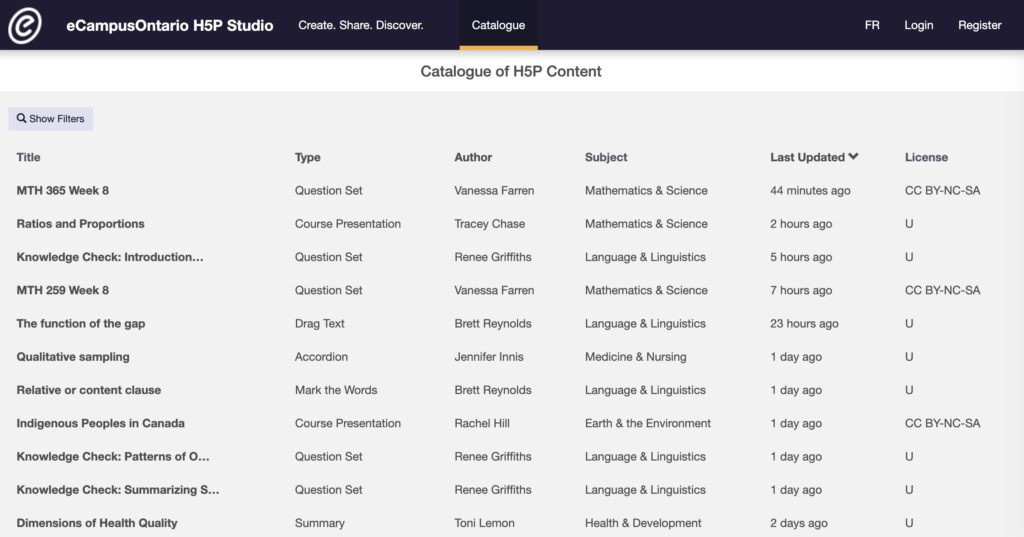
In the H5P Studio eCampus, educators across Ontario have built an extensive collection of H5P content, organized by content type, subject area, and license.
While contributing H5P content is limited to educators in Ontario, the collection is free to explore by anyone. Depending on the license options of the person who uploaded content, the H5P activities listed are usually open to download and remix (as this is built into the H5P system).
Yes, you can browse page by page (all 67 85 177 pages), but the savvy kitchen move is to open the left side search tool by clicking “show filters” in the upper left.
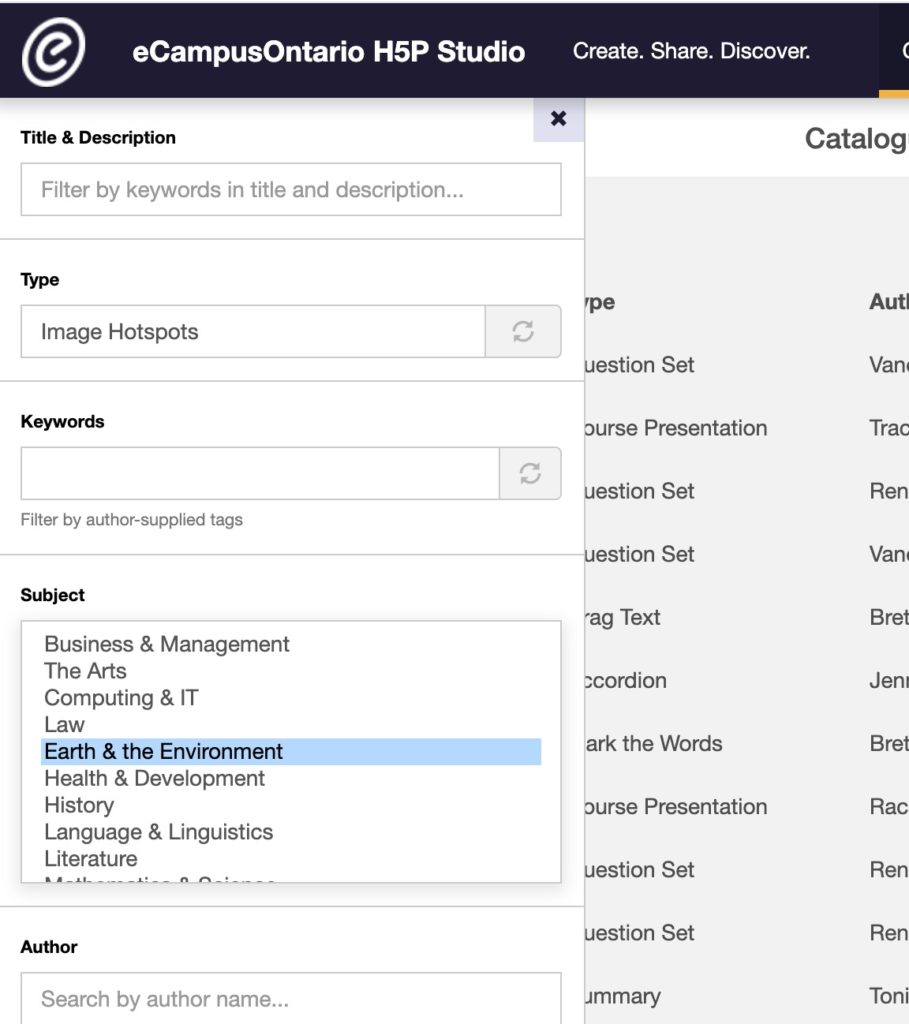
Very quickly I can get to 15 results of using the Image Hotspot in Earth & the Environment. You can also search by keyword in the title, author name, and also filter by license type.
So if you are looking to find examples of what the content types can do, you can make a search just for Branching Scenarios or the curiously named Agamotto.
Another way one might use the filters is to search by discipline, say to show all H5P content created for Law or Medicine and Nursing.
The H5P Studio is a tremendously useful resource for finding H5P content. Since he first iteration of this workshop, it’s developer Yasin Dahi has developed and open source version via Learnful. We will use a demo version later in this workshop, but you can also find a wealth of content in the version at LibreTexts called LibreStudio. And for another collection (created with slightly different software) see the H5P Catalogue.
What to do in a Studio
- Use whatever means to find in any of the studios a relatively simple H5P that catches your interest, something with a delightful aroma! I sifted through the Medicine and Nursing items, and landed on the drag the words activity for Thoracic Vertebrae created by Brenda Magajna at Lakehead University.
- Bookmark or make note of the web address you found it at, in this case it is https://h5pstudio.ecampusontario.ca/content/13133
- Beneath every H5P content you will find similar links that provide access to download the source
.h5pcontent (a download that contains everything needed to remix it), information on the rights of use, and code to embed the activity into any web site.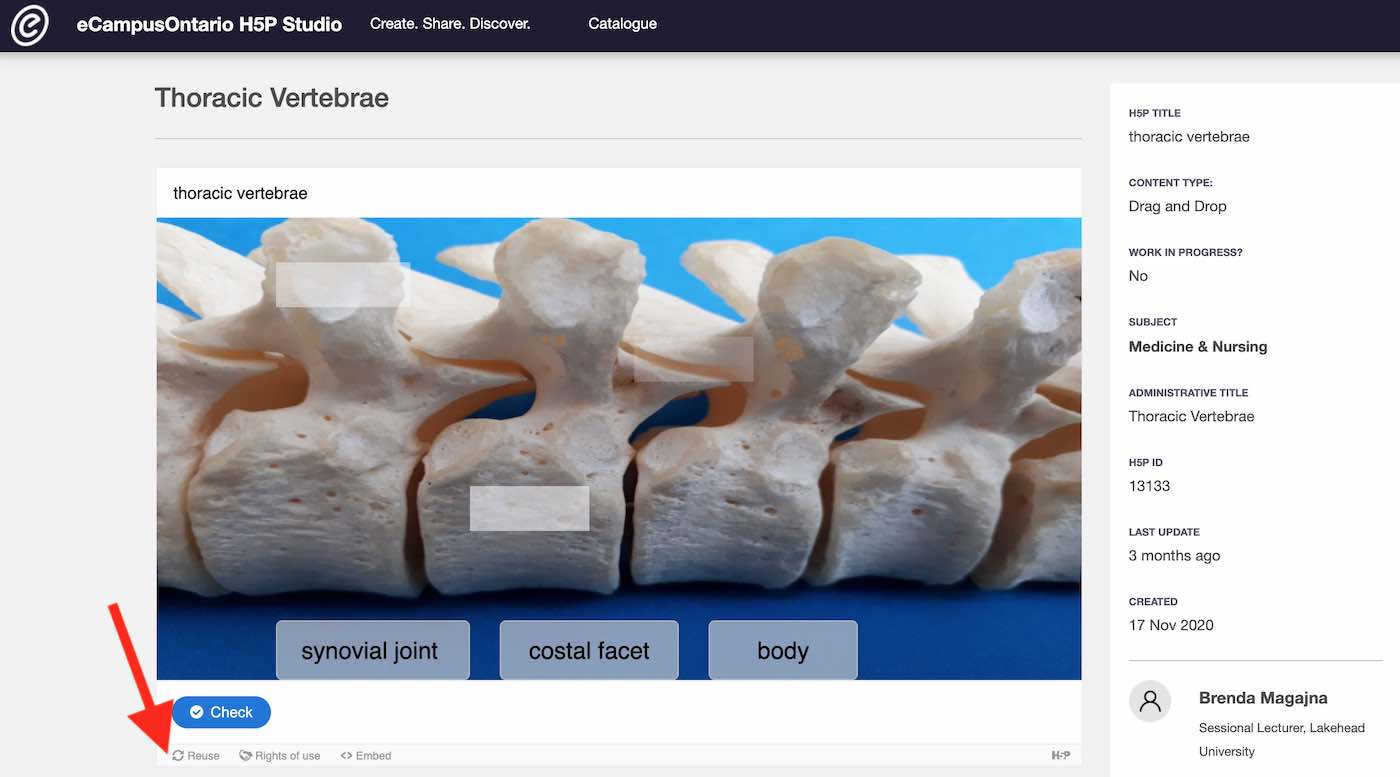
Follow the Reuse link that then allows you Download as an .h5p file. Save this file in a good food storage bin (e.g. some place on your computer you can find later). - Share what you found from the Studio in this form https://forms.gle/iSCKpWtmJ9kdk3ix7
- Find and share more, or try the OER Directories method below.
Looking for Examples in an OER Directory
Because more open textbook platforms are incorporating H5P and other OER collections contain OER content, you can make use of their search tools to find some tasty H5P. We start in detail with the Pressbooks Directory.
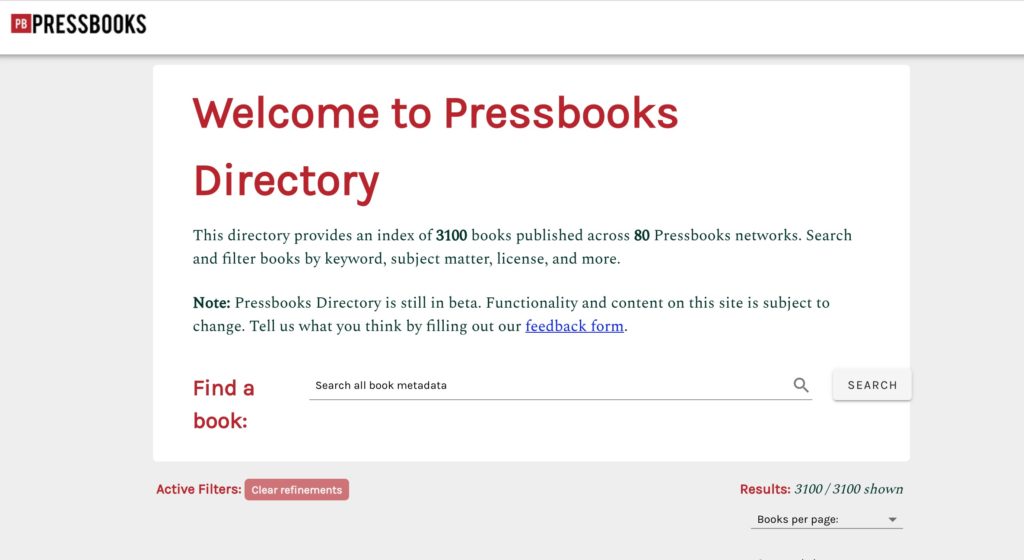
On its own this directory is incredibly useful for those looking to find open textbooks, as it indicates it includes 3,677 books published across 122 Pressbooks networks.
There are many many filters for narrowing your search- by license, modification date, academic subject, word count, file size, and a whole lot more. Just scroll down and look for this friend:
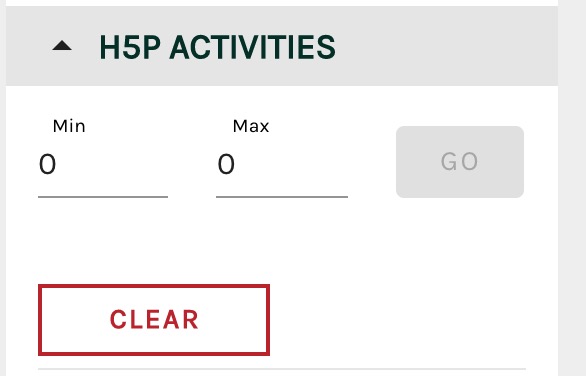
You can limit search to find published Pressbooks with some range of H5P activities. If you are looking for say, anything in Mathematics that uses H5P, select the subject and a minimum of “1” for H5P.
Out of the titles listed for Mathematics, I found 11 that had at least 1 H5P inside of it. These are identified in the results with an H5P icon.
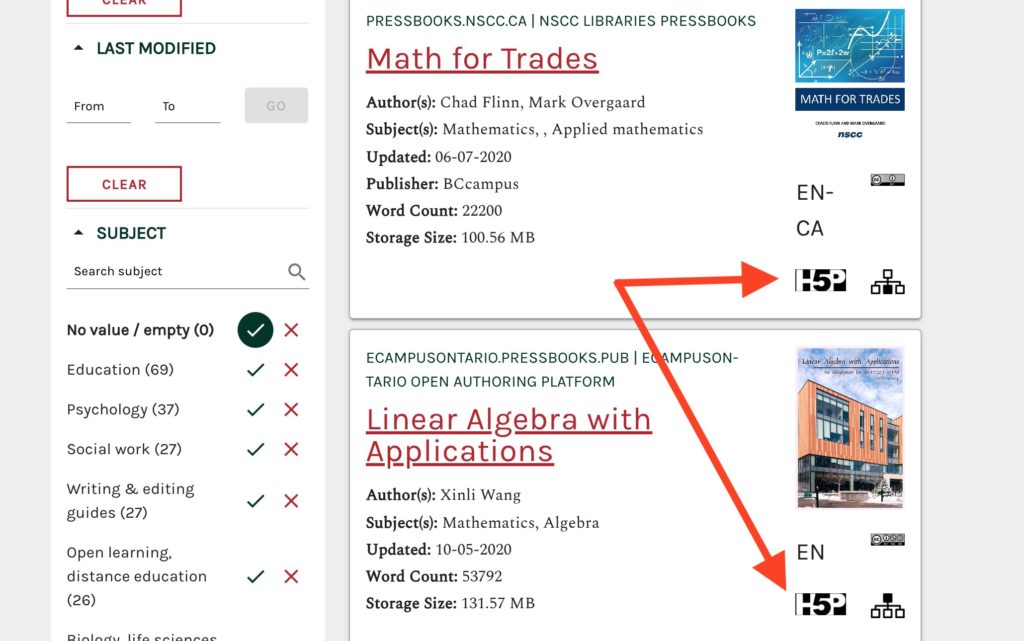
So this is definitely useful to find Pressbooks published textbooks in a given discipline that have H5P content.
Another strategy I used when I was looking for examples of Pressbooks that had an extensive range of examples (so you are not looking at ones that put in maybe a few Accordions or just a handful of multiple choice reviews) is to enter a larger number for the minimum number of H5P activities.
For example, I found 105 Pressbook titles that had more than 100 H5P pieces inside. How else would I have found Atlas of Renal Lesions in Proteinuric Dogs?
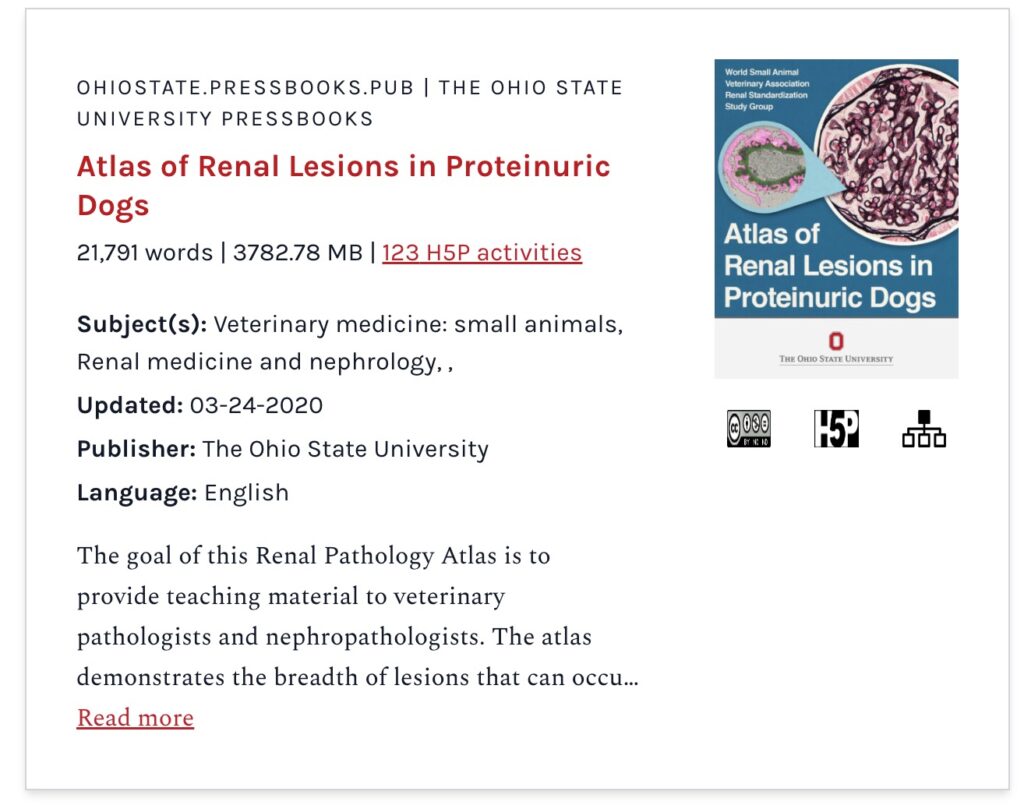
Now if Renal Lesions are your interest, you might just start browsing the book. But the Pressbooks Directory results offers a direct link to see all of the H5P content included inside, see above for the link to view all 123 H5P activities in Atlas of Renal Lesions in Proteinuric Dogs
If you study the web address for that link I have a trick that you can use to find the all H5P in any published Pressbooks.
The Pressbooks URL Trick
To see all of the H5P activities in a single Pressbooks title, just tack /h5p-listing onto any Pressbooks web address.
If I had not found it in the Pressbooks Directory above, and maybe just stumbled across the Atlas of Renal Lesions in Proteinuric Dogs Pressbook, I just go to it’s URL https://ohiostate.pressbooks.pub/vetrenalpathatlas
then slap on the end of it /h5p-listing, or directly https://ohiostate.pressbooks.pub/vetrenalpathatlas/h5p-listing/
Boom!
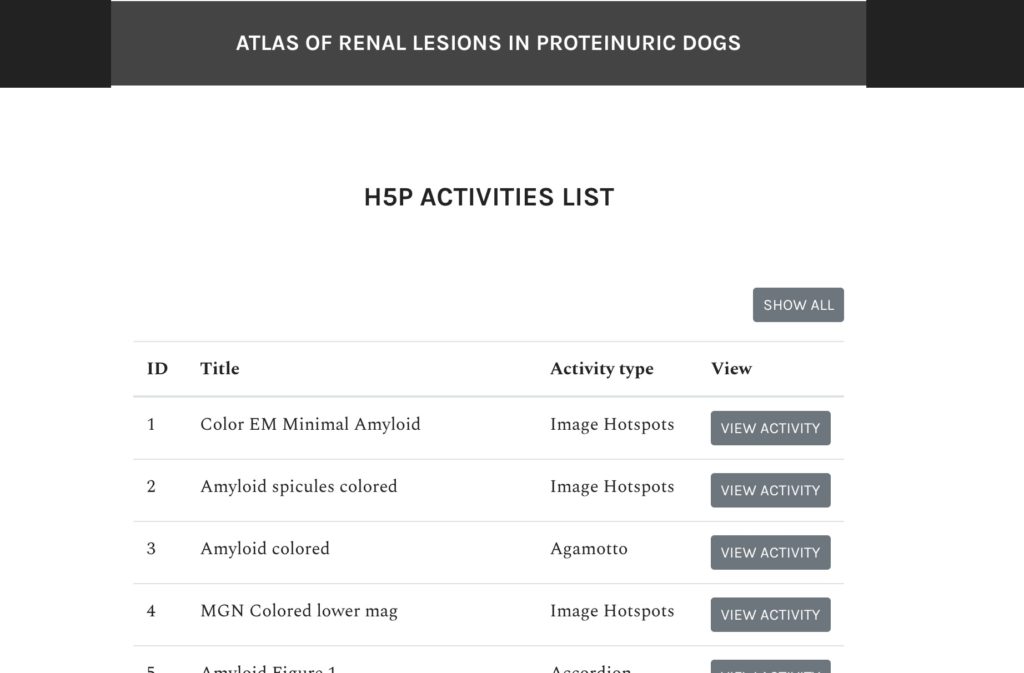
More than that, you can view all of the activities. Look an example of Agamotto:

I might have to read the book to know what amyloid spicules are, but this activity lets me see different parts of this image which are colored at the different drag points (hey this Agamotto tool is cool!).
If the authors had published more openly, the H5P content would be available under a “Reuse button”, but not everyone wants to share their amyloids.
Other OER Directories to Search
Whether you use Pressbooks or not, the Directory is useful for locating H5P content, and if it is published openly, you should find links to download the source .h5p file. Some other directories you might try include:
- B.C. Open Collection – from a leader in OER development, BCcampus has a new searchable collection of open textbooks and standalone activities that can be filtered by discipline. Results indicate if it makes use of H5P or you can start with that as a search term
- OER Commons – Use H5P as a search term
- MERLOT – another collection searchable by H5P as a search term
What to do in an OER Directory
- Use the search method described above to find in an OER Directory a title of interest to you and also one that contains H5P content. Save it’s web address. For example in Pressbooks Directory, I selected the Chemistry category and set the minimum number of H5P activities to 10. I chose to sample from the H5P included in Introductory Organic Chemistry at
https://openoregon.pressbooks.pub/introductoryorganic/ - … where 67 H5P content items can be explored .
https://openoregon.pressbooks.pub/introductoryorganic/h5p-listing/
Taste a few activities and find a relatively simple one that catches your interest for its function or use of a tool. Make sure the ones you pick are enabled with the reuse button (some authors do not allow this, tsk tsk). From the Organic Chemistry list of H5P activities, I might like the use of Image sequencing to order structures by boiling point - Beneath every H5P content look for similar links to this
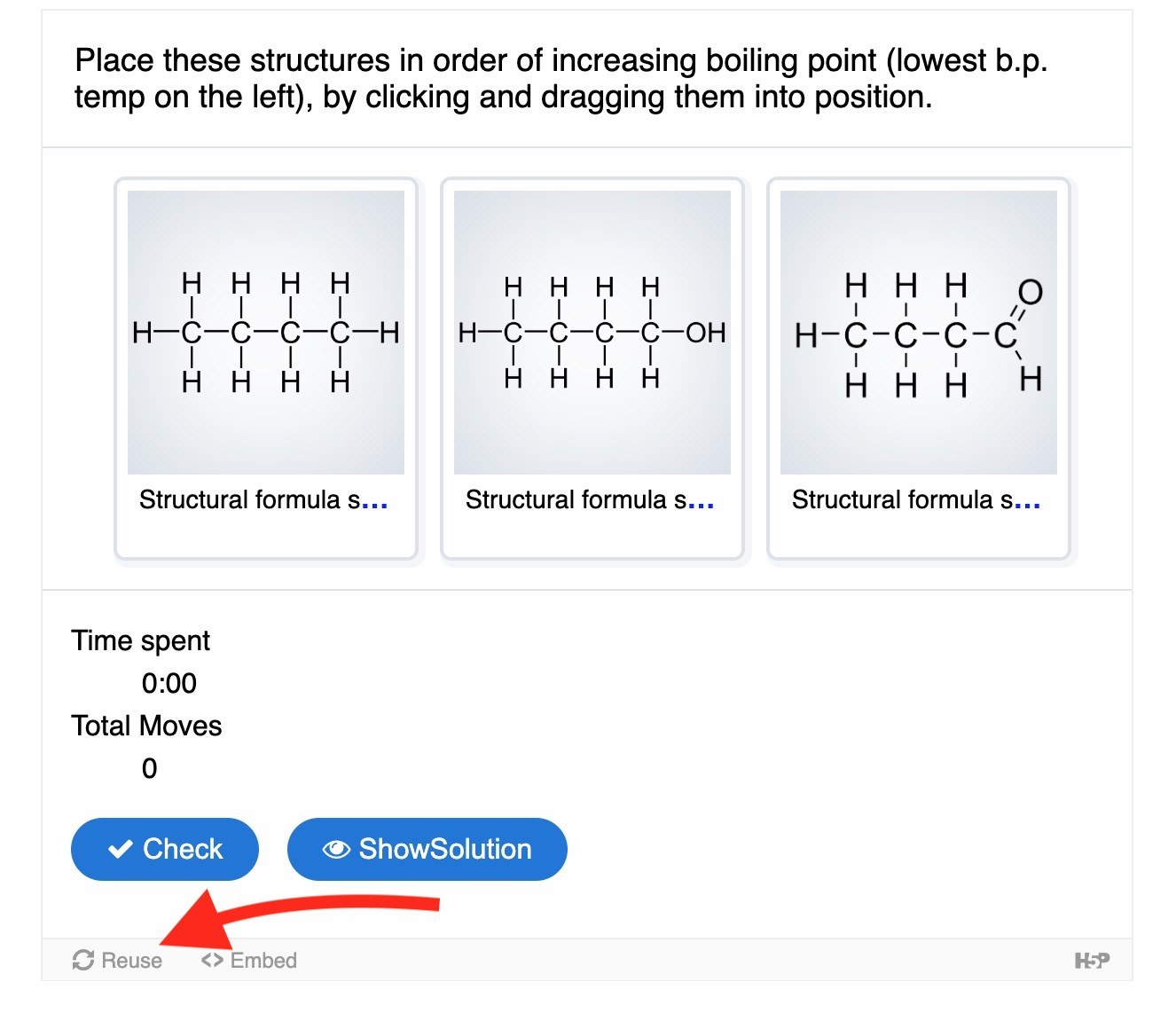
Click on Reuse to access a link for Download as an .h5p file. Save this file in your handy food storage bin (e.g. some place on your computer you can find later). - Share what you found in this form https://forms.gle/iSCKpWtmJ9kdk3ix7
- Find and share more, or try the Studio method above.
If you are curious see the items others have shared into the kitchen web form.
More Cooking
Next, move on to another section of this workshop or return to the entry of the workshop.
- You Don’t Start Cooking By Reaching into the Utensil Drawer
- Remixing from H5P Hors d’oeuvres
- Stepping Up to More Complex H5P Dishes
Learn More
Featured Image: Image by Jill Wellington from Pixabay
